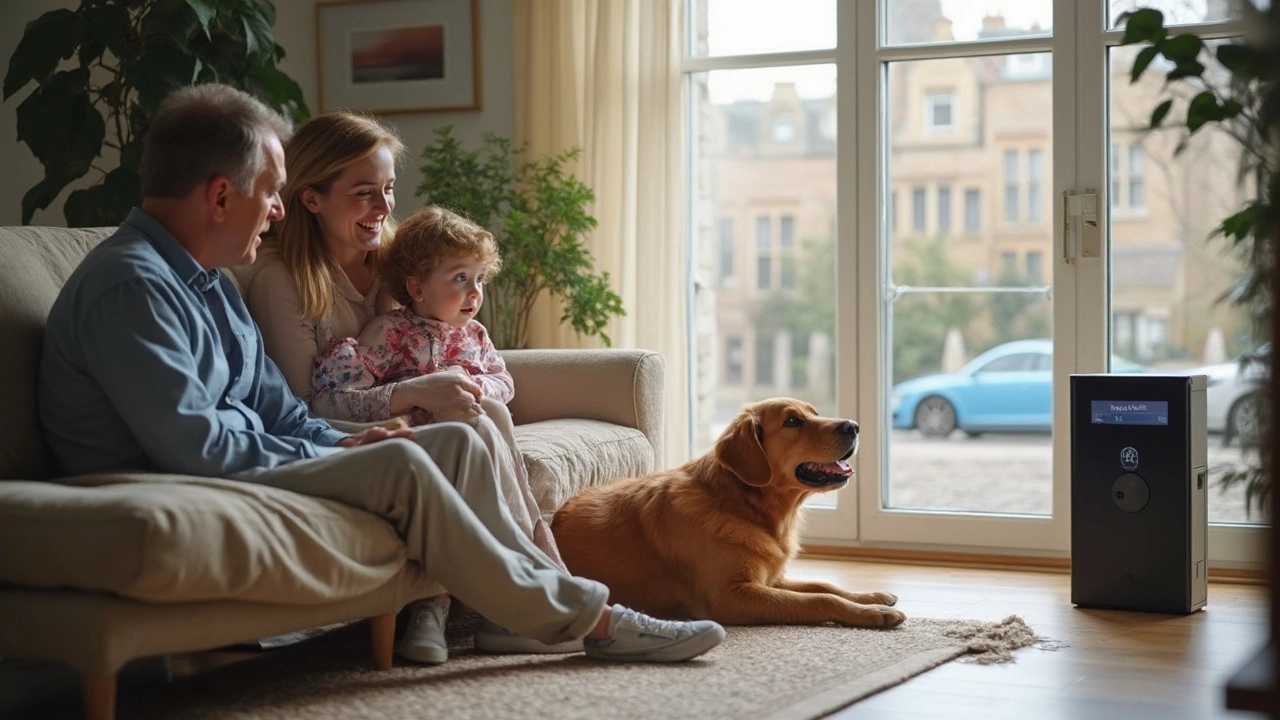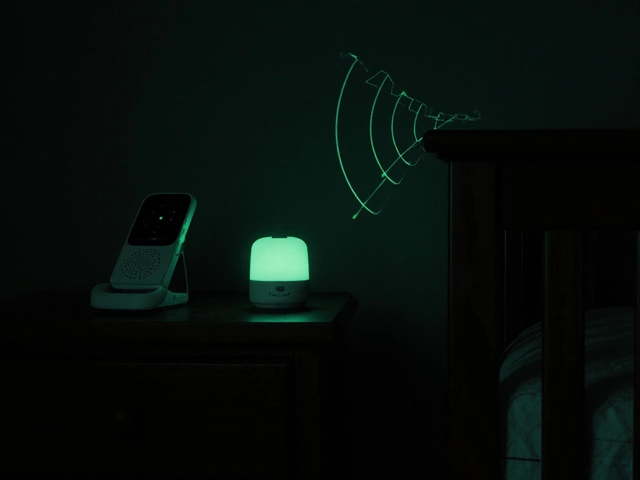You head out, lock up, and right as you’re halfway to work, your phone dings—house alarm triggered. Your heart races. Burglars? Nope, just your dog, happily wagging her tail in the living room. If you’ve ever worried whether Fido could really set off your fancy home security system, you’re not alone. It’s a sneaky, frustrating problem that a lot more dog owners run into than you might think.
How Do Motion Sensors Work—and Do They React to Dogs?
Let’s break it down. Most standard house alarms rely on something called motion detection technology. These sensors are built to spot movement in protected areas, using infrared, microwave, or a combo of both to pick up heat and motion. When anything that meets their programmed criteria moves, boom—the alarm is tripped.
Now, here’s where things get sticky with pets. Old-school sensors didn’t care whether intruders were two-legged or four. Any movement, any heat signature, would set them off. That’s why you get horror stories about chihuahuas setting off panic alarms at midnight or elderly cats leading to unwanted police visits. You would think technology would have fixed this, right?
It kind of has, but not all the way. Most modern systems have what are called “pet-immune” or “pet-friendly” motion detectors, which ignore motion from animals up to a certain weight—usually advertised as 40, 50, or 80 pounds. This sounds like it solves the problem, but these weight limits aren’t foolproof. Short-legged bulldogs might slide by, but an energetic border collie jumping onto the sofa can still get flagged. The angle of the sensor, furniture height, and how the sensor “sees” movement all matter more than the exact pet weight sometimes.
And let’s talk numbers. According to a 2023 survey by the Security Industry Association, about 47% of homes with security alarms also have pets. Of those, nearly 30% reported at least one false alert in the last year caused by their pet. That’s not exactly rare. Most of those cases involved motion sensors tuned for “pet immunity”—proving that marketing alone can’t solve dog-related false alarms.
Check out this quick breakdown of common sensor types and their pet-friendliness:
| Sensor Type | How It Works | Pet-Friendly? |
|---|---|---|
| Passive Infrared (PIR) | Detects changes in heat patterns | Often, if labeled for pets (to a point) |
| Microwave | Sends out microwaves, looks for reflection changes | Less pet-friendly, can pick up movement through walls |
| Dual-technology | Combines PIR and microwave | Most reliable for pets, but can still fail if not set up right |
| Glass break sensors | Listens for breaking glass | Not triggered by pets |
| Contact sensors | Detects doors/windows opening | Not triggered by pets unless they open doors |
It’s tempting to feel safe as soon as you see that “pet-friendly” label, but check the small print and see what weight and movement the sensor actually ignores. And keep in mind, even the beefiest pet sensor won't help you if your dog likes to leap onto counters or climb furniture. The sensors are often calibrated for movement below a specific height, not just weight—so a 30-pound terrier on the ground is fine, but the same dog on the kitchen island can still trigger the alarm.

What Makes a Home Security System Truly Pet-Friendly?
So, now you’re probably wondering, “What system really works with pets?” Here’s what you should look for if you want alarms that won’t get touchy every time your pooch chases his tail.
- Pet Immunity: This is the big one. Go for motion sensors labeled with true “pet immunity”—make sure it matches your dog’s actual weight and size, not just a rounded estimate. Some high-end systems can be programmed for specific pet profiles, which lets you tweak the allowed weight and movement patterns.
- Sensitivity Adjustment: Many quality sensors let you fine-tune their sensitivity. This matters more than people think. Set it too low and you risk ignoring a real break-in; set it too high and your corgi will become public enemy number one every time he strolls past.
- Proper Placement: Where you mount the sensor can be the difference between daily nuisance alarms and peace of mind. Experts suggest placing them about six to eight feet off the ground and pointing them away from spots your dog likes to climb. If your dog clears the back of the sofa like it’s a hurdle at Westminster, aim high and adjust the angle.
- Two-Way Verification: Some systems now send notifications to your smartphone and wait for you to confirm before alerting emergency responders. It buys you a minute to check the security cam and make sure it’s the dog, not someone trying your windows.
- Diversify Sensors: Don’t only use motion. Contact sensors and glass-break detectors won’t respond to your dog’s zoomies or tail-wagging. Modern security setups often use them in tandem, focusing the motion detectors on less dog-accessible areas.
- Professional Help: If you’re overwhelmed, just admit it and call in a pro. Security technicians can map out “dog safe” security zones and set up the system to give both you and your pooch some breathing room.
There’s another angle a lot of people miss: your dog’s breed and personality. Greyhounds are couch potatoes, basset hounds rarely leap anything, but border collies and terriers? They see obstacles as mere suggestions. Watch your dog for a day and you’ll quickly spot routines and favorite spots—use that info when configuring your security system.
Statistics back this up. A 2024 study from PetSecure found that households with active breeds (think Australian Shepherds, Jack Russells) were 2.5 times more likely to have a motion-triggered false alarm than homes with lapdogs like Pugs or Shih Tzus. This shows you can’t just base your decision on the sensor—your dog’s daily antics play a bigger role than most folks expect.
And don’t rule out non-dog triggers. Think about your settings: big ceiling fans, fluttering drapes, or even a wandering Roomba can add to the mix and confuse less sophisticated sensors. That’s why some owners just opt for security cameras or systems with AI-driven motion analysis that “learn” to ignore regular pet paths.
One last tip: test your security system. Have a friend or family member arm the system, then watch as your dog roams the house. See what triggers it, and adjust accordingly. This step saves tons of stress—and possibly some awkward calls from the neighbors.

Common False Alarm Scenarios and How to Avoid Them
Picture this: it’s 2 AM and you’re jolted awake by your phone’s blaring siren. You rush downstairs, adrenaline pumping—only to find your golden retriever chilling by the window. False alarms don’t just annoy you; repeated incidents can cost money if your security company or local police start charging for wasted responses. So let’s talk about when dog-caused false alarms happen most and what you can do to keep things sane.
A huge source of false alarms? Dogs jumping onto furniture right in a motion sensor’s field of view. Your sofa sleeper or countertop explorer is a known culprit. The fix is usually sensor placement: either mount the sensor above the reach of your pet, or angle it away from high-traffic pet areas. If your dog really loves to launch onto things, use a combo of glass break and door sensors so you’re not relying just on movement detection.
Another issue? “Multiple pet chaos.” If you have three dogs, a cat, and a rogue ferret, all bets are off. Even so-called pet-immune sensors struggle to ignore a crowd of animals. In these homes, security experts suggest focusing sensors in less pet-populated areas—like hallways or between external doors and more restricted interior rooms.
Miscalibrated sensors are another big pain. Sensors not set up by a pro can easily trigger at the wrong time—detecting the wag of a tail or the swish of a dog’s body as “unknown activity.” Most systems let you adjust the range or scale of what’s detected, but it takes a little trial-and-error to get it right.
Ever heard of heat blooms? On hot days, your dog—not so much a problem indoors with air conditioning, but in a sun-baked room—can build up enough heat to throw off a PIR sensor. That’s why some experts recommend a dual-tech sensor for rooms that get a lot of sunlight or have south-facing windows.
Here’s a bullet-list of common dog-triggered alarm scenarios and their quick-fixes:
- Dog jumps on furniture under motion sensor: Move sensor higher or angle it away.
- Dog passing by doors with contact sensors: If your pet can open doors, secure them or disable those sensors when you’re home.
- Dog barks near glass-break sensor: Some sensors react to high-pitched barks—choose modern models that filter out animal noises.
- Multiple pets at once: Spread sensors out, avoid overlap, use alternate types like cameras or contact sensors to minimize motion triggers.
- Heat waves or sunlight: Use dual-tech sensors or shield standard sensors from direct sunlight.
Smart home tech is making things a bit easier for pet owners. Some new systems leverage AI analysis to “learn” your dog’s usual travel patterns and mass, ignoring anything that matches those. Others sync to your smartphone and let you override or ignore certain triggers—all through a tap.
Want the least amount of hassle? Use multiple types of sensors: contact and glass-break for entry points, and limit motion sensors to rooms your dog never enters. If you do want video monitoring to check in on your pet, choose cameras with pet-specific modes or apps like Petcube, which combine home security with pet entertainment.
Last fact bomb: some home insurance discounts require you to report every false alarm. Too many can spike your premiums. It pays off (literally) to get your system dialed in to your dog’s habits, not just your doors and windows.
So, will your dog set off your house alarm? It’s possible—especially with an older system or adventurous pup. But with the right balance of tech, setup, and common sense, you can keep your security solid and your pooch from being the neighborhood alarmist.


